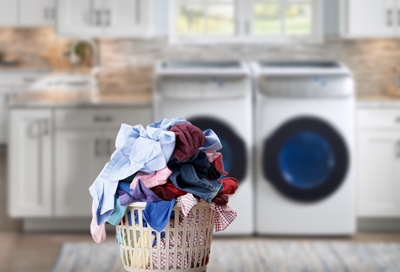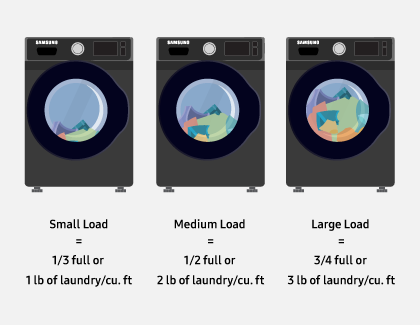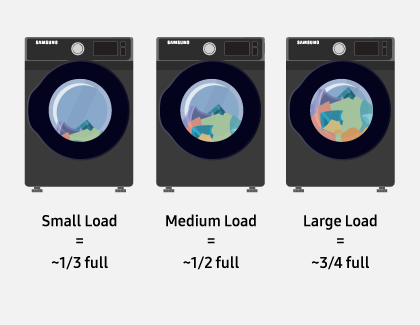The best laundry load size for your Samsung washing machine and dryer

To get the best results when you’re doing laundry, it’s important to consider the weight of each load that you’re washing. Small, heavy items can overload your washing machine and dryer just as much as large, lightweight items. Overloading your washing machine or dryer can reduce the cleaning performance and potentially cause other issues with your appliances as well. Because of this, you’ll want to make sure you’re adding your clothing and other items in the best way possible.
Load your washer
Determining how much weight the washer can handle is based on its capacity in cubic feet. The easiest way to measure the load size is to estimate the load’s weight. The minimum recommended weight for your washing machine is 3 pounds.
A small load of laundry is when the tub is approximately 1/3 full or 1 pound of laundry per cubic foot of the washer's capacity.
A medium load of laundry is when the tub is approximately 1/2 full or 2 pounds of laundry per cubic foot of the washer's capacity.
A large load of laundry is when the tub is approximately 3/4 full or 3 pounds of laundry per cubic foot of the washer's capacity.

Based on these measurements, when using a washing machine with 4.0 cubic feet of capacity, you would consider a 4-pound load small, an 8-pound load medium, and a 12-pound load large.
If you don’t want to physically weigh your laundry, you can estimate it based on the clothing items you’re washing. Here are some common examples you can use to help estimate the load’s weight:
Bath towels are about 1.5 pounds each
A full-size bed sheet is about 1.25 pounds
A large sweatshirt is about 1 pound
Extra large shirts are about half a pound each

Your washing machine will detect the weight of the load and automatically adjust the optimal water level, washing time, rinse counts, and spin counts based on the cycle that is selected.
When adding clothes to your washing machine, make sure you're not packing or pushing the laundry down; your items should be in a very loose pile with no crowding. For instance, large items such as comforters and blankets should fit snug and not be cramped. In terms of weight, heavy materials like wool should be limited to 4.4 pounds or less, and comforters and blankets should be limited to 6.6 pounds or less.
Load your dryer
Loading your dryer is a little less complicated compared to loading your washing machine, since the load size isn't as critical.
Refer to the list below or the diagram to determine the load size for your laundry:
1 small load of laundry is when the drum is approximately 1/3 full
1 medium load of laundry is when the drum is approximately 1/2 full
1 large load of laundry is when the drum is approximately 3/4 full

Remember not to overload the dryer, as this may reduce its performance. To prevent this problem, the dryer should never be more than 3/4 full. Also, your clothes will not dry properly if there are too few items in the dryer. At least 3 to 5 items are recommended and will ensure the sensors in your dryer can properly detect the laundry’s dry level if you're running a Sensor Dry cycle.
Other answers that might help
-
Mobile 8 AM - 12 AM EST 7 days a week
-
Home Electronics & Appliance 8 AM - 12 AM EST 7 days a week
-
IT/Computing 8 AM - 9 PM EST 7 days a week
-
Text Support 24 hours a day 7 Days a Week
Contact Samsung Support


